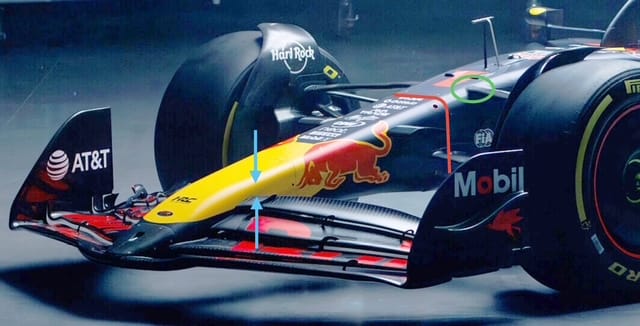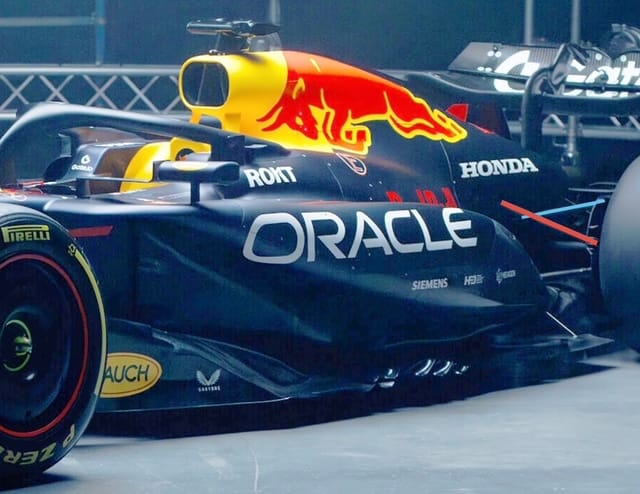Red Bull has just released the first pictures of its new car for 2025, and I have to ask why it has bothered given what we've seen appears to be a few shots of a polished-up 2024 car with lighting and background that makes it very difficult to see anything.
The devil is in the detail of these cars and there's little detail to go on here. But having enhanced the images as best as possible we can at least pick out a few features even if it is just the finer details of the 24 car and we'll have to wait for the real 2025 car to run in public tomorrow to get a proper look.

It looks like the car has a very shallow nose profile. The trailing edge of the inboard ends of the flaps is almost at the top surface of the nose (light blue arrow). The front bulkhead, which I have put at the nose-to-chassis intersection (red highlight) is defined in the regulations. It might be just a little further rearward, but it looks as low as allowable.
The inboard end of the top front wishbone forward leg is raised right to the top of that surface (green ellipse). This is fairly common practice, but it makes me wonder about the suspension geometry. We hear a lot about how inadequate the tyres are and how difficult they are to get into a working window, but if you simply abuse them and only have them there to hold the car up then what do you expect?
The suspension geometry should be all about maximising the tyre contact path as best possible through its working range, that range is, low speed with very little vertical or lateral load, through to high speed with huge vertical and lateral load, between those two you have high longitudinal loads during braking. In all of these scenarios, the tyre contact patch area can be your friend or if the geometry is simply defined for aerodynamic reasons, your enemy.
There's never been a better time to join The Race Members' Club on Patreon - where you can get early access to many of Gary's columns for The Race plus ad-free episodes of his and Edd Straw's The Race F1 Tech Show podcast. Join now and get 90% off your first month.
Red Bull has retained the nose-to-front wing forward flap cover panel which means no slot gap. With this middle section of the front wing being the most forward and lowest section, it could produce a small amount of front load at lower speeds.
The numbers are probably small, but anything at lower speed can reduce the understeer. However, the airflow getting to the leading edge of the underfloor could very easily suffer.

From this side view of the radiator intake, sidepod and engine cover, the whole thing doesn’t look much different. Red Bull had quite a few versions of engine cover and radiator exits last year, so this could very well be one of those.

It retains the pushrod-operated rear suspension (red highlight) with a reasonable amount of anti-lift on the top wishbone forward leg (light blue highlight). But it's not to the excess we have seen on the McLaren.
Gary Anderson's 2025 technical analysis
Read: Analysis of 99% new Ferrari
Read: Mercedes' surprising 2025 F1 car analysis
Read: Aston Martin's AMR25 analysis
Read: Sauber's worrying initial 2025 F1 car
Read: McLaren's 2025 F1 car analysis
Read: Williams FW47 analysis
That’s about it for now. We'll see more of the car, perhaps as the day progresses or certainly on Wednesday and I'll be interested to take a close look at the real car.
For now, this is little more than a news flash confirming Red Bull is up and running for 2025.



